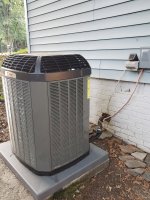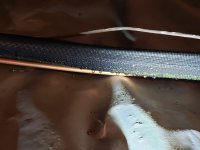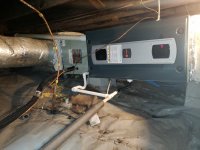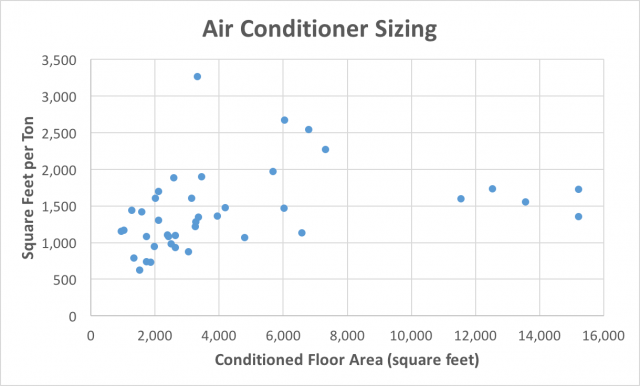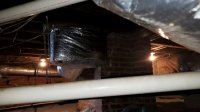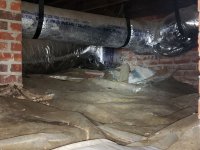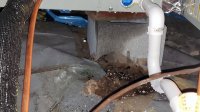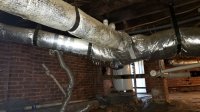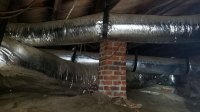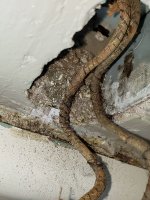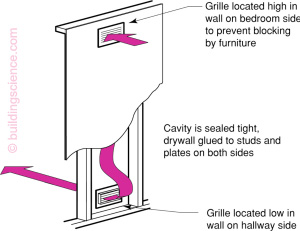When retrofitting higher SEER equipment onto existing ducts it's pretty common to find that the return plenum is undersized for the air flow, even when dropping a half-ton in capacity.
There could also easily be high duct leakage issues undercutting performance. I'm assuming the ducts and air handler are in a VENTED crawlspace? If yes, any air drawn in to the return plenum is going to be high humidity outdoor air. Both the supply and return ducts need to be well sealed, and preferably insulated and RIGH SIZED for the application.
The fact that it's noisy is a clue that either the ducts are leaking or undersized, resulting in high duct velocity & high static pressures. Whenever possible it's best to keep all duct velocities under 400 feet per minute, which will usually have a HUGE benefit on reducing noise (even in somewhat leaky ducts), whereas many systems are running north of 600 feet per minute.
It's highly unlikely that a 1200' house has a design cooling load of 2.5 tons, even when allowing for a half-ton of duct losses from having the ducts & air handler outside of conditioned space. If there are doored off rooms with supply registers and no dedicated return path the rooms become pressurized, using "The Great Outdoors" as part of the return path, bringing in copious quantities of humid air whenever the air handler is running. This can usually be fixed (methods vary by the particulars)- take a look at your supply & return register layout, see if that could be contributing factor.
A typical 1200' house in the southeastern US would have a 1% design load of about 1 ton (not including duct losses) and would be better served by a 1.5 ton AC fully inside both the pressure and insulation boundary of your house to all but eliminate duct loss issues. This plot of square feet per ton from real Manual-J calculations was put together by
a consulting company in Decatur GA, not all that far from you:
Note that literally all ten houses <2000 square feet had a ratio no worse than a ton per 600', with the average being about a ton per 1000'. Unless your house is the crummiest house in SC a 2.5 tonner is going to be sub-optimally oversized for your home. Shooting for a 1.2x oversize factor on cooling, and 1.4x oversize on heating usually provides the best comfort, though with multi-stage equipment 1.5x isn't going to be an efficiency or comfort disaster. So if you're at the typical ton per 1000' range your load would be 1.2 tons, and (1.2 tons x 1.2x=) 1.44 tons would be ideal, and (1.2tons x 1.5x = ) 1.8 tons might still be OK. If it's not cutting it at 2.5 tons you almost certainly have excessive duct losses &/or high air handler driven outdoor air infiltration.
The S9V2B060U3PSBB furnace is also CRAZY oversized for a 1200' house at SC style +22F to +31F 99%
outside design temps in that state. Assuming there is a bit of fluff in the walls & attic, glass in the windows and doors that shut, a reasonably air tight 1200' home would come in under 25,000 BTU/hr @ +20F, and could easily be less than 15,000 BTU/hr (if not right now, could be with some modest air sealing and insulation upgrades.) My 2x4 framed sub-code antique house is twice that size, in a much colder climate and has a design load of less than 40,000 BTU/hr @ +5F (the local 99% design temp), and could be fully heated even at the 37,800 BTU/hr LOW fire output of that furnace! The ~58K high fire output would be good down to about -30F (yup, central AK type winter temps.) My house is on top of a reasonably sealed & insulated but not directly 1600' basement (in addition to the 2400' of above grade), so the duct losses in the basement are true losses. But even if yours are in a vented crawlspace or pier foundation it's unlikely that your design load + duct losses add up to my load numbers.
So where do you go from here?
#1: Assess and fix any duct leakage and return path issues. Again, see if the return paths need improvement. It may be "worth it" to design and implement an all new duct system based on a room by room Manual-J.
#1a: Don't count on HVAC contractors to get it right. Run your own room by room load numbers using freebie Manual-J-ish tools such as
CoolCalc or
LoadCalc. Take your time, and be somewhat aggressive on the air leakage & R-value numbers, even though we know your ducts and house are probably leaky, since the big leaks can probably be fixed pretty quickly & cheaply. Look at your coldest-month gas bill and
run a fuel-use based load calculation logging heating degree-days against gas use as a sanity check. Unlike Manual-J, that is a direct measurement (using the furnace as the measuring instrument), and will automatically include duct losses & air handler driven infiltration loads. In many cases the Manual-J numbers using those tools will come in higher than the fuel-use numbers, but if you have major duct leaks or a horribly unbalanced duct system.
If biting the bullet on all new ducts, insist on a target duct velocity of 400 - 500 fpm on all ducts, not the typical 700-1000 fpm. If the crawlspace were sealed and insulated you could safely go even slower than 400 fpm, but if currently outside the insulation & pressure boundary of the house <400fpm could result in unacceptably high wintertime duct losses.
#2: Get serious about air sealing the house, including air sealing the duct boots to the sub floor, and all electrical & plumbing & flue penetrations of the subfloor and attic floor.
#3: Consider putting down a ground vapor barrier then air sealing and insulating the perimeter foundation wall (if crawlspace) or skirting (if pier foundation.) When the house & ducts are reasonably air tight, and the ducts & air handler all reside inside the pressure & insulation boundary of the house the ability of the systems to control heat & moisture flows in the house become radically improved, enhancing indoor air quality, and increasing comfort, even when the systems are 2x-3x oversized for the 1% & 99% cooling/heating loads (which is where you would be in the "after reasonable upgrades" picture of the house, if not already.)

